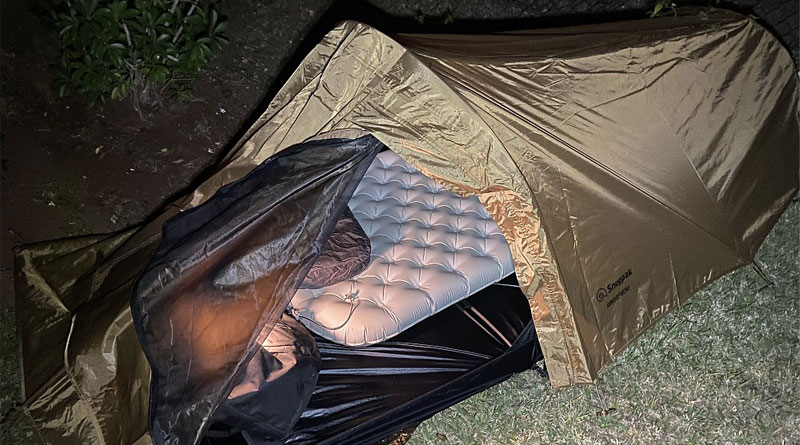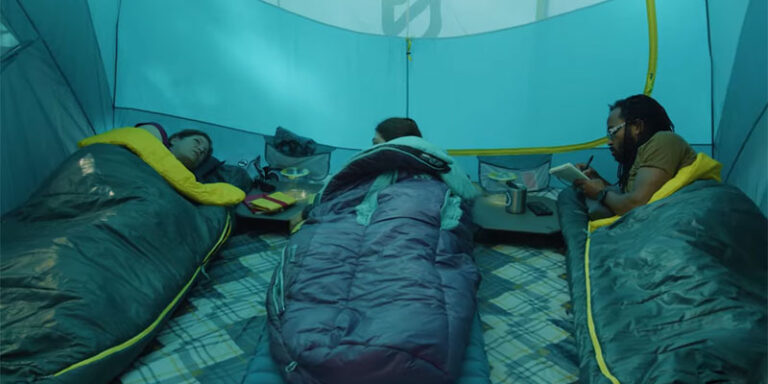Looking for a compact and versatile solo shelter for your outdoor adventures? Look no further than the Snugpak Ionosphere! This British-designed tent offers the perfect blend between a one-person tent and a hooped bivvy, making it a top choice for adventurers seeking stealthy wild camps or exposed pitches. Its low-profile design keeps you inconspicuous and excels in shedding wind, ensuring a practical and comfortable experience on hills, moors, and mountains. Available in two colorways – drab olive or terrain camo – the Ionosphere underscores its clandestine credentials, making it an ideal companion for any outdoor excursion.

Weight: 3.3 pounds (1.49 kilograms).
Dimensions: 104 inches (265 centimeters) long and 39 inches (100 centimeters) wide.
Materials: 210T polyester for rainfly and floor.
Ventilation: No-See-Um mesh for airflow.
Setup: Color-coded poles for easy assembly.
Why the Ionosphere?
When it comes to choosing the Snugpak Ionosphere, it’s all about getting a shelter that’s perfect for sleeping. You see, I use it mainly to rest when I’m out in the wild or when the weather gets a bit too harsh. This tent isn’t really designed for hanging out; it’s more of a place to catch some Z’s or seek refuge from the elements like rain, cold, wind, or pesky bugs. But that’s okay because when I need extra space for cooking or other camp chores, I simply pitch a tarp alongside it.
One of the things I love about the Ionosphere is its stealthy nature. Its low-profile design and small size make it easy to conceal, which comes in handy for those stealthy wild camps or when I want to stay hidden in populated areas. Plus, it’s available in different colors, like drab olive or terrain camo, adding to its clandestine credentials.
But it’s not just about being sneaky. The Ionosphere is also incredibly practical. It’s lightweight, durable, and easy to set up, making it the ultimate survival shelter in my opinion. Whether I’m camping in the wilderness or doing urban survival training, this tent has got me covered. And thanks to its weatherproof construction and excellent ventilation, I always feel safe and comfortable inside.
Sure, there are other shelter options out there, like tents or hammocks, but none offer the same level of stealth and protection as the Ionosphere. And while it may not be the lightest option on the market, its durability and versatility more than make up for it. So if you’re looking for a reliable shelter that’s perfect for quick stealth camps or survival situations, the Snugpak Ionosphere is definitely worth considering.
Construction and Durability
When it comes to the construction of the Snugpak Ionosphere, you can trust that it’s built to last. From its tough materials to its sturdy design, this tent is made to withstand the rigors of outdoor adventures. The seams are all taped sealed, ensuring that no water gets inside even during heavy rain. Plus, the floor is made from durable polyester, while the rainfly is constructed from ripstop polyester, both coated to be waterproof.
The Ionosphere features two sets of DAC Featherlite NSL aluminum poles with press-fit connectors. These poles are not only lightweight but also strong enough to withstand strong winds and rough handling. However, it’s important to keep the connectors clean to ensure smooth assembly and disassembly.
While the Ionosphere may not be the lightest tent on the market, it certainly doesn’t skimp on durability. Its robust construction means it can handle some serious abuse without showing signs of wear and tear. Whether you’re camping in the wilderness or setting up a makeshift shelter in urban areas, you can trust that the Ionosphere will hold up to the challenge.
Field Performance
Out in the field, the Snugpak Ionosphere proves its worth time and time again. Its practical design and sturdy construction make it a reliable companion for all sorts of outdoor adventures. Setting up the Ionosphere is a breeze, taking no more than a few minutes thanks to its straightforward assembly process. Just open the floor, assemble the poles, stake everything down, and throw the rainfly on top – it’s that easy.
Whether I’m camping deep in the wilderness or finding a hidden spot in the city for some stealth camping, the Ionosphere never fails to impress. Its low-profile design and small footprint make it easy to conceal, allowing me to stay hidden and safe from prying eyes. Plus, its weatherproof construction means I can rest easy knowing that I’ll stay dry even during the heaviest downpours.
But it’s not just about staying dry – the Ionosphere also excels in keeping bugs and insects at bay. The No-See-Um mesh provides excellent protection, ensuring a peaceful night’s sleep without any unwanted visitors. And thanks to its decent ventilation, I never have to worry about feeling stuffy or claustrophobic inside the tent.
One of the things I appreciate most about the Ionosphere is its versatility. With a few modifications and improvisations, I’ve been able to use it as a four-season shelter, even in sub-zero temperatures. And while it may not offer the same amount of space as larger tents, it’s more than enough for me and my gear. Overall, the Snugpak Ionosphere is a reliable and practical shelter that never fails to impress in the field.
Comfort and Thermal Management
Inside the Snugpak Ionosphere, comfort meets practicality in a cozy space designed for rest. Despite its compact size, there’s enough room for me, my gear, and even my two small dogs to sleep comfortably. However, it’s worth noting that the tent’s low-profile design means there’s limited headroom – I can wiggle around and turn, but sitting up isn’t an option.
When it comes to thermal management, the Ionosphere does a commendable job of keeping me comfortable in various weather conditions. Ventilation is provided by the space between the rainfly and the ground, while the bathtub-style floor helps keep things dry and prevents colder drafts from sneaking in. Even in cold temperatures, condensation isn’t an issue thanks to the tent’s two-layer design.
During the summer months, I search for shaded spots or pitch a tarp to protect from direct sunlight, as things can get quite warm inside when the air is still. However, increasing airflow by keeping the rainfly port open helps mitigate this issue. And while I’ve only used the Ionosphere without the rainfly a couple of times, I’ve found that rolling it down partially while leaving the top open provides a good balance between ventilation and protection.
What I like about this tent
- Stealthy Design: The low profile and small footprint make the Ionosphere perfect for stealth camping or staying hidden in urban environments.
- Weatherproof: With taped seams, waterproof floor, and durable materials, the Ionosphere keeps you dry and protected even in heavy rain or strong winds.
- Easy Setup: Assembly is quick and straightforward, requiring only a few minutes to pitch the tent and stake it down.
- Durability: Built to withstand rough conditions, the Ionosphere’s robust construction ensures it can handle plenty of abuse without showing signs of wear and tear.
- Versatility: With a few modifications, the Ionosphere can be used as a four-season shelter, protecting a wide range of climates.
- Bug Protection: The No-See-Um mesh keeps insects and bugs out, ensuring a peaceful night’s sleep without any unwanted visitors.
What I don’t like about this tent
- Limited Space: While adequate for one person and their gear, the Ionosphere may feel cramped for taller individuals or those who prefer more room to move around.
- Minimal Headroom: Due to its low-profile design, there’s limited headroom inside the tent, making it difficult to sit up comfortably.
- Not Freestanding: The Ionosphere requires multiple stakes for pitching, which may be inconvenient in rocky or hard-packed terrain.
- Moderate Weight: While not excessively heavy, the Ionosphere may be considered slightly heavier compared to other ultralight shelters on the market.
- Limited Ventilation Options: While the tent provides decent airflow, there are few options for adjusting ventilation beyond opening the rainfly port.
- Price: While offering excellent value for its features, the Ionosphere may be considered relatively expensive compared to budget options.
Alternatives and Comparisons
If you’re considering the Snugpak Ionosphere but want to explore other options, there are a few alternatives worth considering from the same brand.
The Snugpak Stratosphere is another one-person bivy tent that offers a lightweight option. However, this comes at the expense of a double-layer design, making it less breathable and roomier than the Ionosphere. The Stratosphere is ideal for those seeking a more minimalist shelter option.
On the other hand, the Snugpak Journey Solo is similar to the Ionosphere but slightly heavier. While it shares many features with the Ionosphere, such as weatherproof construction and bug protection, it may not be as suitable for those prioritizing weight savings. However, if durability and space are more important factors, the Journey Solo could be a suitable alternative.
In terms of comparisons outside of the Snugpak brand, there are numerous options on the market.
For example, the MSR Hubba NX is a popular one-person tent known for its lightweight design and spacious interior. While it may offer more comfort and headroom compared to the Ionosphere, it may not match its stealthy design or weatherproof construction.
Alternatively, hammocks like the ENO SingleNest paired with a tarp provide a lightweight and versatile shelter option. However, hammocks may not offer the same level of protection from insects or weather as a traditional tent like the Ionosphere.
Final Verdict
In conclusion, the Snugpak Ionosphere emerges as a reliable and practical shelter option for outdoor enthusiasts seeking a blend of stealth, durability, and weather protection. Its low-profile design and compact footprint make it ideal for stealth camping or staying hidden in urban environments, while its weatherproof construction ensures you stay dry and comfortable even in adverse conditions.
While the Ionosphere may have some limitations such as limited space and minimal headroom, its ease of setup, durability, and bug protection outweigh these drawbacks for many users. Additionally, its versatility allows for use in various climates with a few modifications to enhance thermal management.
When considering alternatives, options like the Snugpak Stratosphere or Journey Solo offer similar features with slight differences in weight and design. Outside of the Snugpak brand, other tents like the MSR Hubba NX or hammocks paired with tarps provide alternative shelter options with their own strengths and weaknesses.



